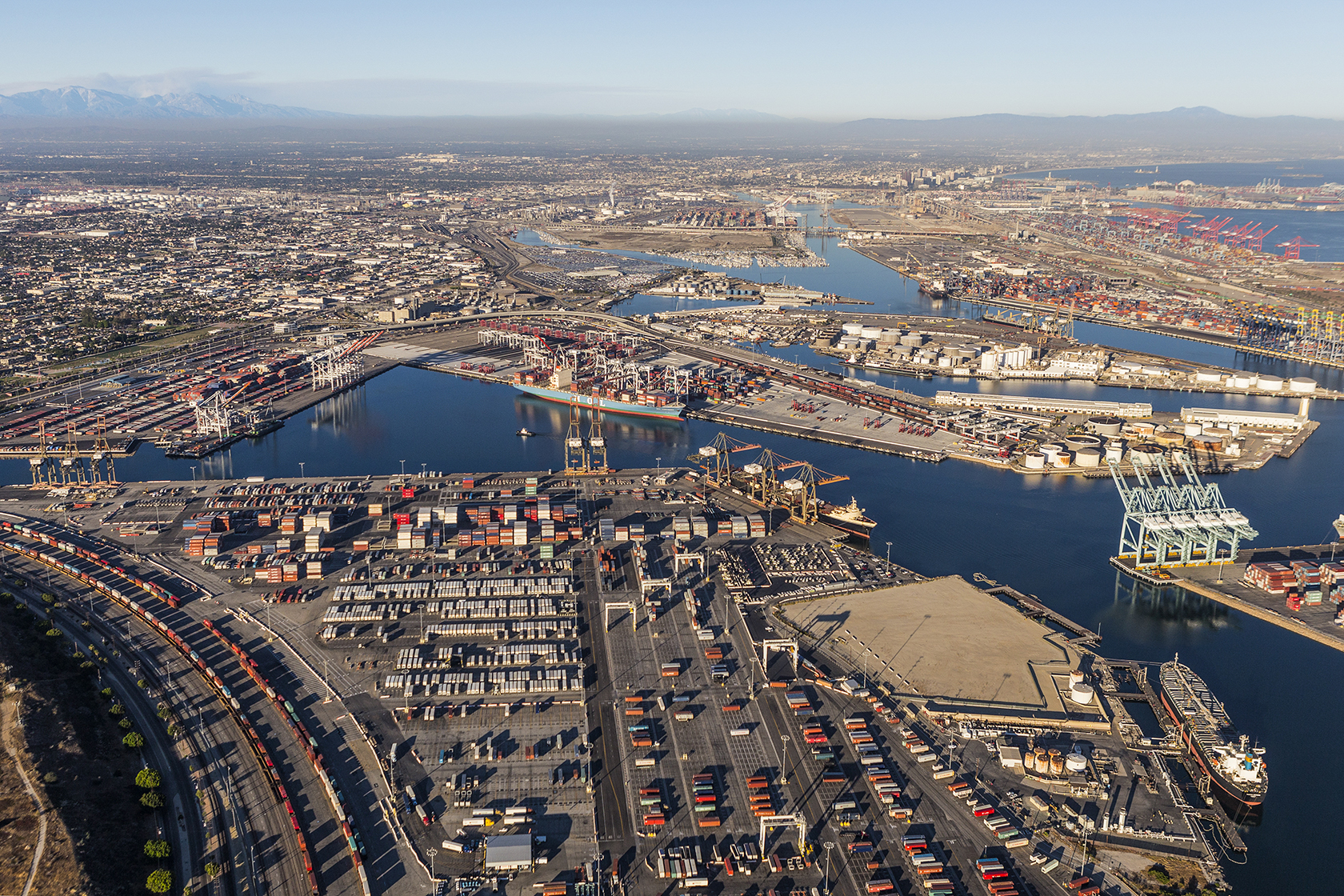On July 22, the U.S. Environmental Protection Agency (EPA) awarded a $500 million grant to the South Coast Air Quality Management District’s (South Coast AQMD) INVEST CLEAN program to decarbonize the transportation and freight sectors in Southern California.
This funding, enabled by the Biden administration’s Inflation Reduction Act, represents the largest single grant under the EPA’s $4.3 billion Climate Pollution Reduction Grants (CPRG) program—and the largest awarded grant in South Coast AQMD’s history. INVEST CLEAN will decarbonize the goods movement system in the densest shipping corridors in Los Angeles, Orange, Riverside, and San Bernardino counties, and this grant provides a critical investment in reducing greenhouse gas (GHG) emissions and improving air quality. Securing funding for this important program was made possible through the technical expertise and leadership provided by ESA and several key contributors.
A Region Burdened by Air Pollution
This part of Southern California is home to more than 17 million people, or roughly 44 percent of the entire state’s population. Population density, economic activity, topography, and weather patterns in the region have combined to create some of the poorest air quality in the country. For decades, elevated levels of ozone and fine particulate matter have caused the region to be designated as a nonattainment area by the EPA under the Clean Air Act. Major contributors to this pollution are the trucks, trains, and other freight equipment needed to move goods from the massive ports of Long Beach and Los Angeles throughout the region and beyond.

Consequently, the region’s residents are breathing some of the worst air in the nation, especially in low-income, disadvantaged communities that are near freeways, train tracks, warehouses, and other shipping activity. Amidst these concerning public health issues, the South Coast AQMD—the regulatory agency responsible for improving air quality in the region—developed the INVEST CLEAN program, in partnership with cities, counties, and local and regional agencies, to decarbonize the transportation and goods movement sector.
What is INVEST CLEAN?
Formally known as the Infrastructure, Vehicles, and Equipment Strategy for Climate, Equity, Air Quality, and National Competitiveness program, INVEST CLEAN will encourage strong partnerships and collaboration between many air quality stakeholders, including local and regional agencies, the State of California, labor organizations, and community participants.
Emissions reductions will occur by investing in zero-emissions, battery-electric technologies for switcher locomotives, Class 8 trucks, cargo-handling equipment, and last-mile freight delivery by medium-duty vehicles. All told, these measures will cumulatively prevent the release of 12 million metric tons of GHG emissions, 1,600 tons of nitrogen oxides (NOx), and 30 tons of diesel particulate emissions, and save more than one billion gallons of diesel fuel by 2050.
“INVEST CLEAN is a transformational initiative aimed at overcoming barriers and transitioning the Southern California goods movement corridor to zero-emissions technologies, from the coast to the border,” says Jeff Caton, Climate Planning Services Director.

“This concentrated investment in zero-emissions vehicles and infrastructure in the nation’s premiere international trade gateway will be a catalyst for reducing local and regional emissions and protecting the climate.”
Jeff Caton, ESA Climate Planning Services Director
Caton explains that the program will help scale zero-emissions technologies and infrastructure, enabling their implementation throughout the national supply chain. It will also foster economic growth and community development through a robust workforce training program, manufacturing of U.S.-made vehicles and equipment, and investments into low-income and disadvantaged communities that are most affected by air pollution.
The program is anticipated to create an estimated 470 high-quality jobs in California and 4,700 across the nation, with an additional 43,500 new jobs expected as the infrastructure becomes fully developed.
Priority Climate Action Plans
ESA worked with the region’s CPRG Steering Committees to develop the Priority Climate Action Plans (PCAPs) for the Los Angeles-Long Beach‐Anaheim Metropolitan Statistical Area (MSA) and the Riverside-San Bernardino-Ontario MSA.
Serving as high-level roadmaps for reducing GHG emissions and air pollution, PCAPs identify GHG−and air pollution−reducing measures in the region that are “implementation ready” and suitable for inclusion in grant applications. More than 80 MSAs have received funds through the EPA to develop PCAPs. A PCAP also enables MSAs to apply for a share of the $4.3 billion available through the EPA’s Climate Pollution Reduction Grant program.

“ESA was chosen to develop PCAPs for the Southern California region based on our well-established reputation for developing regional climate action plans and the close working relationships we have with these lead agencies.”
Brian Schuster, ESA Air Quality, Climate, and Acoustics Director
In addition to these collaborative partnerships, a key factor Brian notes, was ESA’s experience on other local CAPs in the region. These include the Los Angeles County 2045 Climate Action Plan adopted by the County Board of Supervisors in June 2024, the Gateway Cities Council of Governments regional Climate Action Planning Framework, and the Western Riverside Council of Governments Subregional Climate Action Plan.
In less than a year, ESA produced PCAPs for both the Los Angeles-Long Beach-Anaheim MSA and the Riverside-San Bernardino-Ontario MSA. This effort involved aggregating regional energy and emissions data, forecasting future emissions, developing priority reduction measures including goods movement, and assessing jobs and community benefits that would result from their implementation. The plans included a focused list of high-priority, implementation-ready measures to reduce GHG emissions within the four counties in the South Coast AQMD and quantified the GHG emissions reductions that would result.
“We are so grateful for this award, which is the largest in our agency’s history and one that underscores the needs of our communities,” said Vanessa Delgado, Chair of South Coast AQMD’s Governing Board. “Over the next 25 years, these funds will help reduce 12 million metric tons of carbon emissions. On top of that, 1600 tons of smog-forming emissions will be avoided annually while creating green jobs and fostering economic growth.”
A Trusted Advisor in Climate Planning
ESA has served as a trusted advisor for thousands of clients in California over our 55-year history as a 100% employee-owned firm. We have the capabilities to tackle important and complex environmental challenges and have a long-established history of working on large-scale climate planning efforts. For more information on the CPRG program or ESA’s Climate Planning services, please reach out to Jeff Caton or Brian Schuster.









